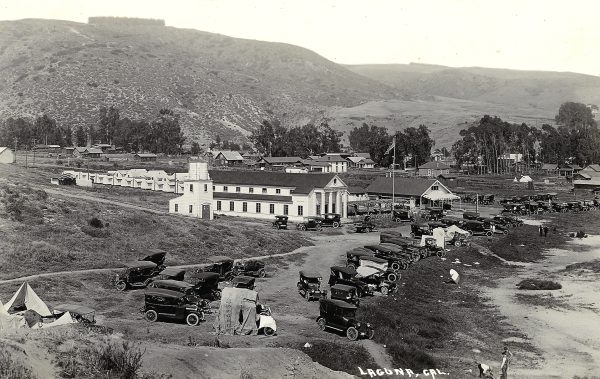The Pomona College Marine Laboratory

Here’s a story that has always puzzled me. Before there was much in Laguna Beach, century-old photos show an impressive two-story structure fronted by Greek columns. Known as the Pomona College Marine Laboratory, it’s across from Main Beach and next door to “Tent City,” an array of forty tents that served as dorms. How did this come about?
The backstory revolves around three unusual characters. The first is Miss Ellen Browning Scripps (1836-1932), a wealthy journalist and philanthropist. Born in London, England, to a newspaper family, she and her half-brother came to America and founded the Scripps newspaper chain, once America’s largest. Scripps, who never married, retired to San Diego to use her wealth for good. She had an interest in marine science and founded the Scripps Research Institute on her La Jolla ranch, which grew into U. C. San Diego. There’s also a Scripps College in the Claremont Colleges.

The second person in our story is James A. Blaisdell (1867-1957) minister, theologian, and in 1910 president of Pomona College. Blaisdell was a visionary who visited Oxford and Cambridge and conceived the Claremont Colleges consortium. It helped that Blaisdell was also a gifted fundraiser who found a benefactor in Miss Scripps. Blaisdell put two things together: the time wasted by students during summer vacations, and Miss Scripp’s interest in oceanography and began a summer marine studies program, first a 1910 camp at Portuguese Bend by Palos Verdes.
The Marine Laboratory might have remained at Portuguese Bend, and the Bixby Estate had offered 30 acres, except for Laguna developer Howard G. Heisler (1870-1941), who in 1905 developed a coastal portion of the Irvine Ranch as Laguna Cliffs (the area around Cliff Drive). To add class to his development, he promised a park along the bluff (the subject of a future column) and gave three lots to Pomona College for a summer Marine Laboratory. Orange County donors also raised money for a building, so Laguna won the competition.
A 1913 Los Angeles Times article reported, “The building which is being erected at Laguna Beach for the Pomona College marine biological laboratory, will be completed in about ten days and ready for summer school occupancy. . ..” Another report told of Heisler’s Laguna Beach Company building a “Tent City” of 40 tents next door for student and visitor housing.
The Marine College was the biggest thing in Laguna after the artists. A 1916 Los Angeles Times article noted: “The best year in the history of Laguna Beach was 1915. A paved road brought autoists by the hundreds. A tent city, many pretty bungalows and a hotel were built along the Laguna-Arch Beach coast. Pomona College’s marine laboratory here will lead to a larger summer school.” The Marine Laboratory so fascinated a new husband on honeymoon that his wife filed for divorce, claiming, “I got no attention at all. He spent our honeymoon mostly in the laboratory…even took his meals there.”
The Marine Laboratory’s unique summer program continued for 31 years until Pomona College sold the property in 1944 to James H. Cannon, a self-educated inventor and founder of Cannon Electric Company, who planned a new laboratory to be built after the war. Unfortunately, Cannon died in 1950 before the laboratory could be built, and the property was sold to General Petroleum and has been a gas station ever since. And that’s the story of the marine laboratory that, in the beginning, shaped our town. There’s meaning in that.
Skip fell in love with Laguna on a ‘50s surfing trip. He’s a student of Laguna history and the author of “Loving Laguna: A Local’s Guide to Laguna Beach.” Email: [email protected]




